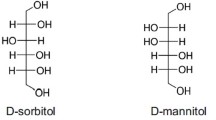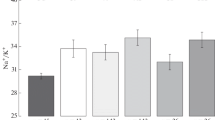Summary
The oral administration of ammonium chloride, sodium bicarbonate or hypertonic sodium chloride to rats caused a decrease in renal cellular protein-bound sulfhydryl (PBSH). A similar effect can be produced by dehydration or the injection of vasopressin. Isotonic saline administration did not produce these PBSH changes or did ammonium chloride or hypertonic sodium chloride produce PBSH changes in hypophysectomized rats. It is thus likely that these salts produced a discharge of antidiuretic hormone via the supraoptico-hypophysial system which in turn produced the PBSH changes described.
Similar content being viewed by others
References
Barnnett, R. J., and A. M. Seligman: Histochemical demonstration of protein-bound sulfhydryl groups. Science 116, 323 (1952).
—: Histochemical demonstration of sulfhydryl and disulfide groups of protein. J. nat. Cancer Inst. 14, 769 (1954).
Cafruny, E. J., H. S. Di Stefano, and A. Farah: Cytophotometric determination of protein-bound sulfhydryl groups. J. Histochem. Cytochem. 3, 354 (1955).
Farah, A., C. H. Bender, R. Kruse, and E. Cafruny: The influence of acidosis and alkalosis on mercurial induced diuresis and sulfhydryl changes in the kidney. J. Pharmacol. exp. Ther. 125, 309 (1959).
Fong, C. T. O., I. L. Schwartz, E. A. Popenoe, L. Silver, and M. A. Schoessler: On the molecular bonding of lysine vasopressin at its renal receptor site. J. Amer. chem. Soc. 81, 2592 (1959).
—, and I. L. Schwartz: On the mechanism of action of the antidiuretic hormone (vasopressin). Proc. nat. Acad. Sci. (Wash.) 46, 1288 (1960).
Molina, G., A. Farah, and R. Kruse: Effect of vasopressin and dehydration on protein-bound sulfhydryl and disulfide groups in renal cells. Amer. J. Physiol. 204, 541 (1963).
Pollister, A. W., and M. J. Moses: A simplified apparatus for photometric analysis and photomicrography. J. gen. Physiol. 32, 567 (1949).
Schwartz, I. L., C. T. O. Fong, E. A. Popenoe, L. Silver, and M. A. Schoessler: Evidence for covalent attachment of the antidiuretic hormone to its receptor site in the kidney. J. clin. Invest. 38, 104 (1959).
—, and C. T. O. Fong: Relation of chemical attachment to physiological action of vasopressin. Proc. nat. Acad. Sci. (Wash.) 46, 1288 (1960).
Teiger, D. G., A. Farah, and H. S. Dr Stefano: Cytophotometric determination of protein bound disulfide groups. J. Histochem. Cytochem. 5, 103 (1957).
Verney, E. B.: The antidiuretic hormone and the factors which determine its release. Proc. roy. Soc. B 135, 25 (1947).
Author information
Authors and Affiliations
Additional information
Dedicated to Professor Otto Krayer on his 65th birthday.
This investigation was supported by United States Public Health Service grant A-2232(C3) from the National Institute of Arthritis and Metabolic Diseases.
Rights and permissions
About this article
Cite this article
Farah, A. The effect of salt administration on the renal protein-bound sulfhydryl concentration in the rat. Naunyn - Schmiedebergs Arch 248, 1–8 (1964). https://doi.org/10.1007/BF00247054
Received:
Issue Date:
DOI: https://doi.org/10.1007/BF00247054




